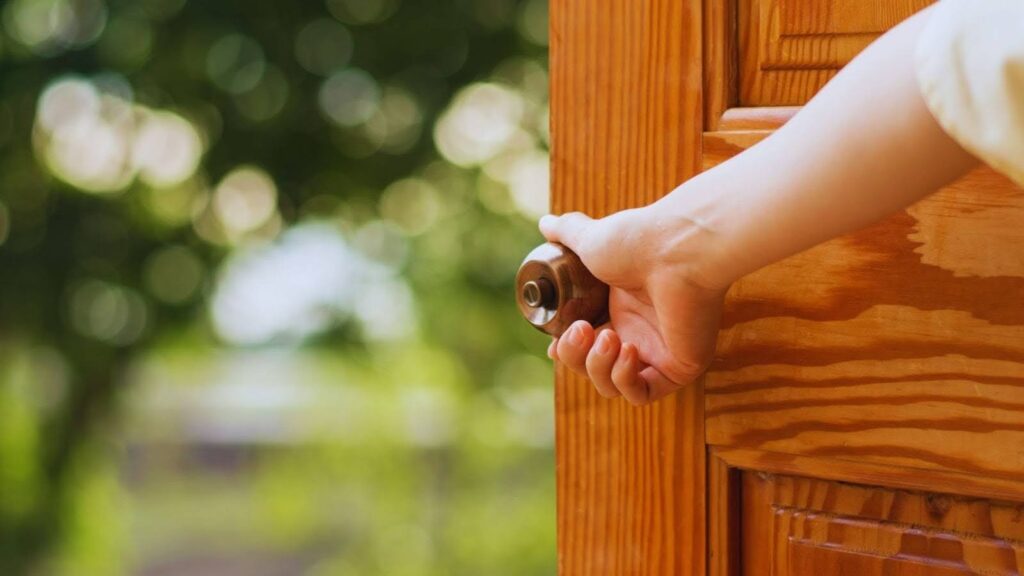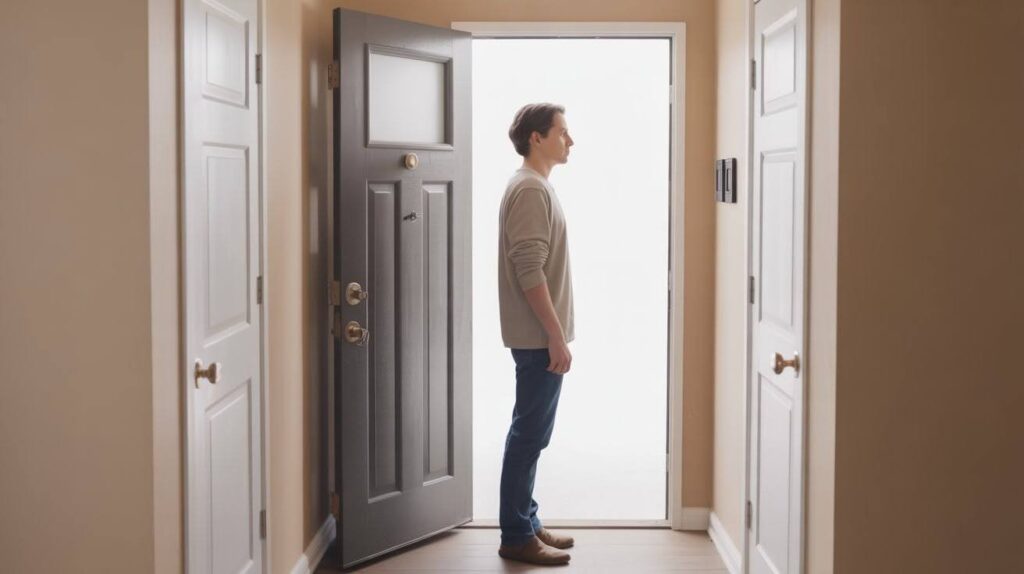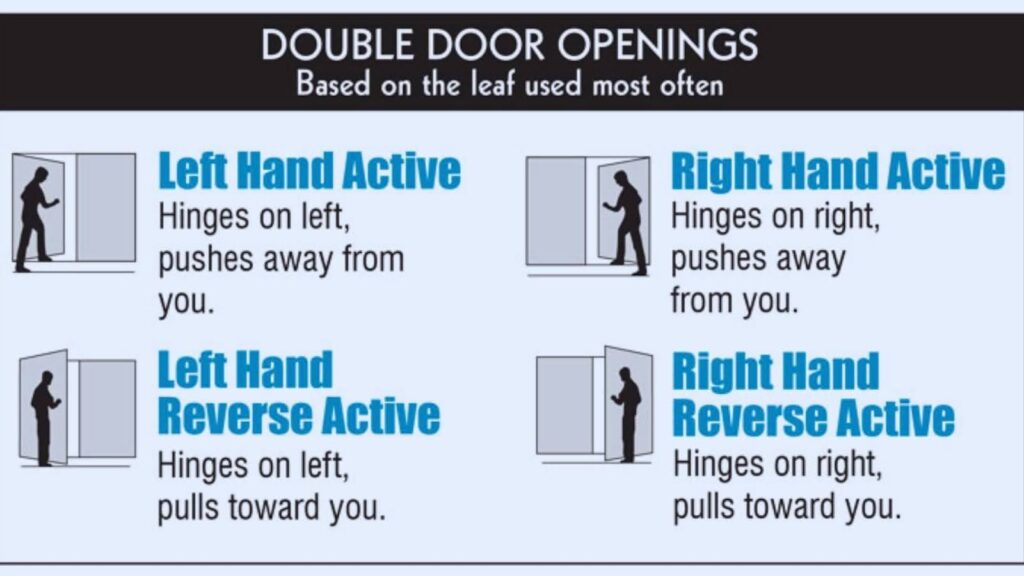I know how frustrating it is to order the wrong door. Been there, done that, and paid for the return shipping. Getting your door swing direction right saves you money and headaches.
This guide shows you exactly how to use a door swing direction chart so you never mess up again. I’ll walk you through single doors, double doors, and the exact steps pros follow.
You’ll learn to spot hinge locations, read swing codes, and pick the right hardware. No confusing jargon, just clear instructions that work.
Let’s get your door order right the first time.
What Is Door Swing Direction?

Door swing direction tells you which way a door opens and where the hinges sit. This matters in homes and businesses because it affects traffic flow, safety, and code compliance. Getting it wrong means wrong hardware, installation delays, and wasted money.
Door swing is about the physical movement when you push or pull. Door handing combines swing direction with hinge placement. Together, they create a complete description of how your door operates.
Two identical doors can work completely differently. One opens left, the other right. One swings in, the other out. This determines what locks fit and where furniture goes.
I’ve seen doors block hallways because someone didn’t check the handing first. Once you learn the basics, spotting door swing becomes easy.
How to Determine Door Swing Direction
Follow these three simple steps to identify your door’s handling every time.
Step 1 – Stand on the Correct Side

Find the secure side of your door first. For exterior doors, stand outside. For interior doors, stand where you’d normally approach the door. This position is called the outside or facing side.
Commercial doors follow the same rule. Stand on the side where you pull the door open. This consistent approach prevents confusion during ordering.
Step 2 – Identify the Hinge Location

Look at your door while standing in the correct position. Are the hinges on your left or right?
Hinges on the left mean a left-hand door. Hinges on the right mean a right-hand door. This simple check is your foundation for determining door handing.
Step 3 – Observe the Door Swing

Watch how the door moves. Does it swing toward you or away from you?
Swinging toward you is an inswinging door. Swinging away is an outswing door. Interior doors usually swing inward. Exterior doors can go either way depending on building codes and weather concerns.
Door Swing Direction Chart (Single Doors)

LH (Left Hand): Hinges sit on the left side. The door swings inward toward you. Common for interior rooms.
RH (Right Hand): Hinges sit on the right side. The door swings inward toward you. Mirror opposite of LH doors.
LHR (Left Hand Reverse): Hinges sit on the left side. The door swings outward away from you. Often used for exterior applications.
RHR (Right Hand Reverse): Hinges sit on the right side. The door swings outward away from you. Exterior doors in certain climates use this configuration.
Double Door Swing Direction Chart

Double doors have their own set of rules based on which door opens first.
Active vs. Inactive Door
The active door is the one you use daily. It opens freely without releasing anything extra. The inactive door stays locked with flush bolts at top and bottom.
An astragal is the vertical strip where both doors meet. It attaches to the inactive door and creates a seal. The active door closes against it.
Common Double Door Handing Types
LHA (Left Hand Active): Left door is active with hinges on the left. Swings inward. Right door stays locked.
RHA (Right Hand Active): Right door is active with hinges on the right. Swings inward. Left door stays locked.
LHRA (Left Hand Reverse Active): Left door is active with hinges on the left. Swings outward. Used in commercial entrances.
RHRA (Right Hand Reverse Active): Right door is active with hinges on the right. Swings outward. Common in high-traffic areas.
Common Methods for Determining Door Handing
The outside-facing method is standard across U.S. manufacturers. Stand on the outside or secure side. Note hinge position and swing direction. This gives you the handing code.
The hinge-facing method works differently. Stand where you see the hinges. Some international suppliers use this approach. Always confirm which method your supplier follows.
Frameless doors or flush-with-wall installations need extra attention. Look for the door jamb or frame edge. Treat the side with the stop bead as the secure side. When in doubt, take photos and share them with your supplier.
Why Door Swing Direction Matters
Getting the swing direction right affects everything from safety to daily function in your space.
Safety and Building Code Compliance:
Fire codes require doors to swing in specific directions for safe evacuation. Outswing exterior doors prevent blockage during emergencies.
Getting this wrong creates liability and fails inspections.
Functional Flow and Space Planning:
Door swing affects furniture placement and room traffic. An inward-swinging door needs clear space inside.
Outward swing clears the interior but may block hallways or walkways. Plan accordingly.
Correct Hardware Selection:
Locks, closers, and handles are handed products. Order the wrong handing and your hardware won’t fit.
This delays projects and doubles your costs. Always verify before purchasing.
Accessibility Considerations:
Door swing impacts wheelchair access and ADA compliance. Lever handles, threshold heights, and clear floor space all depend on swing direction.
Visual symmetry matters too, especially with double doors in entryways.
Practical Tips for Homeowners and Installers
These simple steps will save you time, money, and frustration during your next door project.
- Use a physical chart or download a guide from your door supplier. Keep it handy during measurements. Take photos of existing doors before removing them.
- Common mistakes include measuring from the wrong side or confusing inswing with outswing. Double-check by having someone else verify your findings. Mark the handing code directly on your order form.
- Order one door first if you’re unsure. Test fit it before ordering multiples. This small step saves huge headaches on large projects.
Conclusion
I still cringe thinking about my first door order. Wrong handing meant a ruined Saturday and a hefty return fee. Trust me, you don’t want that headache. Keep your door swing direction chart bookmarked and check it before every order.
Those three simple steps save you hours of frustration. Now when I help friends with their projects, I’m the door handing guy.
Share this with someone tackling a door project. Got questions? Comment below. I’m here to help.
Frequently Asked Questions
How do I know if my door is left or right-handed?
Stand on the side where you approach the door. If hinges are on your left, it’s left-handed. If on your right, it’s right-handed.
What’s the difference between inswing and outswing doors?
Inswing doors open toward you. Outswing doors push away from you.
Can I change my door swing direction?
Yes, but you’ll need to rehang the door and move hinges to the opposite side. The strike plate also needs relocating.
Do all door manufacturers use the same handing system?
Most U.S. manufacturers use the outside-facing method. Some international suppliers differ. Always confirm with your supplier before ordering.
What happens if I order the wrong door handing?
You’ll get a door with hinges on the wrong side. This means returning it, reordering, and delaying your project.

